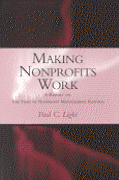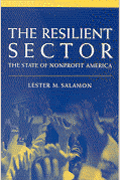By Heather Joslyn
Nonprofit organizations—and the grant makers that support them—need to become more aware of a coming decrease in the available labor pool, and start providing more support to employees and recruiting more aggressively, says Paul C. Light, director of the Center for Public Service at the Brookings Institution, a Washington public-policy think tank that this month released a survey of the nonprofit work force.
With the baby boomers edging toward their retirement years, he says, subsequent generations, smaller in number and in higher demand as workers, will not necessarily turn first to nonprofit work.
“Nonprofits face a real crisis as the labor market matures,” says Mr. Light. “The nonprofit sector has gotten away with this for years: It relies on this highly committed work force that rotates out. They always know that there is always another group of workers coming right behind them.” Part of the solution to the labor crunch, he says, is stepping up recruiting efforts. Many charities, he says, don’t even pitch themselves to their own clients, noting that youth-development groups, for example, may run career fairs for teenagers but often neglect to include themselves or other nonprofit organizations among the employment options.
Charities should especially focus on young adults who are considering government careers, Mr. Light says. He says that the Brookings survey’s results, which show how powerfully charity workers are motivated by mission, suggest to him that nonprofit groups should consider government, rather than business, as the chief competitor for workers who have a passion for service.
Charities, he says, can offer workers the chance to help people without the bureaucratic entanglements that come with government jobs, and small organizations in particular can offer idealistic young people the chance to have a lot of responsibility and make a big impact early in their careers.
“The nonprofit sector always has the recruitment advantage in the early stages, because it offers exciting, responsible work,” he says. “The problem that the nonprofit sector has is that it gets these bright young recruits and burns them out fairly quickly.”
Taming Turnover
Many nonprofit employers, however, remain skeptical that government—rather than business or other charities—is their chief competitor for talent.
The benefits packages offered to federal workers, for instance, are tough for nonprofit organizations to match, they say. And the interest just doesn’t seem to be there, says Janet J. Street, executive director of Girls Inc. of Greater Atlanta, an affiliate of the national youth-development organization. She says that over the last four years, at least two job seekers per month call her for advice on switching from the for-profit to nonprofit fields. No government employees, she says, have done the same.
As vital as hiring new employees can be, Mr. Light says, it is also important to try to tame the nonprofit field’s notoriously high turnover.
Foundations, he says, should play a stronger role in giving charities the help they need to keep their workers happy. Though grant makers are becoming more aware of charities’ organizational needs, he says, they would rather support programs that are directly related to a charity’s mission than invest in operational costs, training, or labor-saving infrastructure, such as technology. Such parsimony, he says, sends a message to nonprofit employees that they are not valued and contributes to turnover.
“We have a first-class work force in second-class organizations,” he says. “And it does eventually wear down that work force.”
The downturn in efforts to bolster charity operations is coming at a time when grant makers are also demanding fuller accountability from their grantees, says Sarah Boxx, the former head of a children’s charity who now serves as client-services manager at Social Entrepreneurs, a management-consulting company in Reno, Nev., that works with nonprofit groups. “They say, ‘We need you to do it like we do it in the business world, with technology, which you also don’t have.’”
One way to tame turnover would be to raise salaries for entry—and midlevel workers, says Sophia Ross-Lloyd, senior vice president for quality at Lakefront SRO, a housing organization in Chicago. Ms. Ross-Lloyd, who has spent her 18-year career in both the government and nonprofit fields, says younger workers are less inclined than her generation was to accept very low salaries even when they believe in a charity’s mission.
Status and Support
Another way to aid the nation’s 11 million nonprofit workers, Mr. Light says, would be to have their employment concerns championed by a federal lawmaker—something that hasn’t yet occurred, he says, and something that is increasingly needed as American charities are asked to serve more clients with fewer government funds.
“I think we’ve done a bad job in the nonprofit sector in recruiting a political advocate,” he says.
A powerful lawmaker, he says, could broker deals that would ease the burdens faced by charity employees, such as helping to create tax breaks for those who are paying back college loans, or offering employees loan forgiveness in exchange for a certain number of years of service to charities.
Nonprofit groups definitely suffer from a lack of status in the labor market and in the political arena, says John Manzon-Santos, executive director of the Asian & Pacific Islander Wellness Center, an AIDS-services charity in San Francisco.
“There are a million nonprofits, and it definitely is the stepchild of the sectors—even in the name, ‘nonprofit,’ it’s less than, it’s not something else,” he says. “So we don’t get a lot of respect, and when there’s respect, resources follow.”







Commentary
Charities and Foundations Must Confront Shrinking Labor Pool, Researcher Says
October 17, 2002